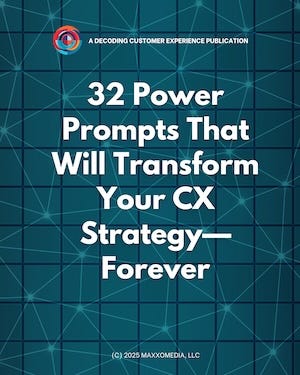‘Customer Engagement’ Is Overrated—Here's What Really Builds Loyalty
Everything you thought you knew about customer loyalty is about to be challenged—are you ready?
📌🚀Unlock Your CX Superpowers with 32 Game-Changing GenAI Prompts
Say goodbye to overwhelm and hello to crystal-clear prioritization. Download your free set of 32 GenAI prompts right now. Prioritize smarter, communicate better, and achieve tangible results—starting today.
Use these prompts with your favorite AI Chatbot to evaluate, prioritize, and communicate your CX initiatives more effectively. Let’s make prioritization less stressful and more actionable!
The Problem: Misunderstanding What Customers Actually Want
Do your customers really care about being 'engaged'?
Do they wake up hoping to build deeper emotional connections with your brand?
Spoiler alert: They don't.
What customers really want—what they're practically screaming for—is a straightforward, frictionless solution to their problems.
The Engagement Illusion
Somewhere along the line, brands got wrapped up in this idea that every interaction had to feel like the start of a beautiful friendship.
But your customers aren't dating your brand.
They're just trying to pay their bills, track a lost order, or fix that weird error message popping up at checkout.
The Myth of the Relationship
Remember when you called customer service about your spotty internet?
Did you care if the agent asked how your day was going or chatted you up about weekend plans?
Nope.
You wanted your Wi-Fi back ASAP.
Brands confuse friendliness with effectiveness.
Sure, a warm greeting can ease frustration temporarily, but if the core issue remains unresolved, you've only painted lipstick on an unhappy pig.
What Research Tells Us
Customers don't need you to be their buddy.
They need reliability, consistency, and speed.
According to a PWC study, over 70% of customers prioritize efficiency and ease of resolution over feeling 'connected' to a brand.
Let that sink in: seven out of ten customers would trade your friendly banter for faster results in a heartbeat.
Engagement without solving the problem isn't just useless—it's annoying.
Join the global community of 1,180+ CX trailblazers who receive the DCX Newsletter first—packed with fresh insights, inspiration, and tools to elevate your customer experience game. Don’t miss out—join the movement today!
The Solution: Focus on Being Indispensable, Not Lovable
Keep reading with a 7-day free trial
Subscribe to Decoding Customer Experience to keep reading this post and get 7 days of free access to the full post archives.





